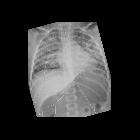Lungenödem bei Beinahe-Ertrinken

Preschooler
found face down in a swimming pool. CXR AP shows a normal sized heart and bilateral perihilar interstitial infiltrates. There is also a dense opacity in the right upper lobe.The diagnosis was pulmonary edema due to near drowning and probable aspiration pneumonia of the right upper lobe.

Near drowning
pulmonary edema • Near drowning pulmonary edema - Ganzer Fall bei Radiopaedia

Near drowning
pulmonary edema • Near drowning (pulmonary edema) - Ganzer Fall bei Radiopaedia

Near drowning
pulmonary edema • Near-drowning pulmonary edema - Ganzer Fall bei Radiopaedia

Preschooler
after an episode of near drowning. CXR AP shows bilateral perihilar infiltrates in a butterfly wing distribution.The diagnosis was non-cardiogenic pulmonary edema due to near drowning.

Near drowning
pulmonary edema • Near-drowning pulmonary edema - Ganzer Fall bei Radiopaedia

Preschooler
found face down in a pool. CXR AP shows bilateral dense confluent infiltrates throughout the lungs.The diagnosis was pulmonary edema from near drowning.
Near drowning pulmonary edema is considered an etiological subtype of non cardiogenic pulmonary edema. It can occur with both salt water and fresh water near-drowning.
Pathology
It is thought to result from the inhalation of either fresh water or sea water resulting in lung damage and a ventilation-perfusion mismatch.
Near drowning can be divided into three stages:
- stage 1: acute laryngospasm that occurs after inhalation of a small amount of water
- stage 2: the victim still usually presents with laryngospasm but may begin to swallow water into the stomach
- stage 3
- 10-15% of patients still present with dry drowning caused by persistence of the associated laryngospasm
- in the remaining 85-90% of patients, the laryngospasm relaxes secondary to hypoxia and large amounts of water are aspirated
Radiographic features
Radiography
Features in stages 2 and 3 on chest radiographs are usually identical to pulmonary edema from other non-cardiac causes .
Siehe auch:
und weiter:

 Assoziationen und Differentialdiagnosen zu Lungenödem bei Beinahe-Ertrinken:
Assoziationen und Differentialdiagnosen zu Lungenödem bei Beinahe-Ertrinken:
